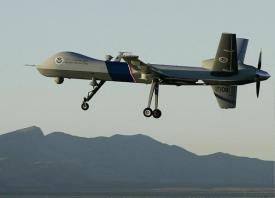 |
| The federal government's existing border effort includes a handful of other unmanned aircraft, 20,000 Border Patrol agents, about 650 miles of border fence and 41 mobile surveillance systems. (Ross D. Franklin) |
|
After years of political pressure from Texas politicians, U.S. Rep.
Henry Cuellar said Monday that he expects the federal government to
deliver unmanned aircraft to watch over the border with Mexico by this
fall.
Cuellar, a Democrat from Laredo, said he has had discussions with
top officials from the U.S. Customs and Border Protection's office of
air and marine operations, and they agreed to the timetable, subject to
Federal Aviation Administration approval to allow the surveillance
planes — often referred to in the political vernacular as "Predator
drones" — to fly over Texas.
Laura Brown, an FAA spokeswoman, said the administration is "working as quickly as we can on this."
Cuellar
said the FAA told him that regulators' main concern has been with
Texas' heavy airplane traffic — both private and commercial.
If
approved, the unmanned aircraft in Texas would add to the federal
government's existing border effort, which includes a handful of other
unmanned aircraft, 20,000 Border Patrol agents, about 650 miles of
border fence and 41 mobile surveillance systems, according to Customs
and Border Protection.
The plane, which is made by General
Atomics Aeronautical Systems and officially called a Predator B, is
able to spot illegal border activity and send images in real time to
border officials.
At that point, Border Patrol agents could be dispatched, according to Customs and Border Protection.
Cuellar
— along with Sens. John Cornyn and Kay Bailey Hutchison and Gov. Rick
Perry — has been trying to bring the unmanned aircraft to Texas for
years.
Cornyn and Perry, both Republicans, have been among the most vocal critics of the regulators' pace.
"Washington
needs to quit fiddling while the border region of America burns," said
Perry, who has been calling for Predators since 2005.
Also last week, Cornyn said that the FAA's pace "borders on foot-dragging."
Cuellar has refrained from using harsh words directed at the FAA.
Instead,
he invited FAA Administrator Randy Babbitt and Alan Bersin, the
commissioner of Customs and Border Protection, to his office on May 20
to make sure an agreement can be reached.
"My interest in this is to get this done as quickly as possible," he said.
Cuellar,
who leads the House Homeland Security Subcommittee on Border, Maritime
and Global Counterterrorism, has asked the FAA to give priority to
Texas' request.
Cuellar and Customs and Border Protection
officials said a home for a Texas-based Predator already has been
identified at Naval Air Station-Corpus Christi.
Kimberly Kasitz, a spokeswoman for General Atomics, said one unmanned aircraft costs $10 million to $12 million.
Discussions
in Washington have centered on bringing one Predator to Texas to be
deployed along the border with Mexico to fight drug trafficking, human
smuggling and violent Mexican drug cartels.
The Texas plane is
still under construction, Cuellar said. If it is not ready by the time
the FAA approves its flight, then one would be borrowed from another
location, Cuellar said. He would not say where because of security
concerns.
Places with unmanned aircraft systems in the U.S.
include Arizona, which has three; North Dakota, which has two; and
Florida, with one.
Unmanned aircraft have grown quickly in
popularity in the defense and surveillance sectors, said Peter W.
Singer, a senior fellow at the Brookings Institution and the author of
"Wired for War: The Robotics Revolution and Conflict in the 21st
Century."
Since 2003, the military has acquired about 7,000
unmanned aircraft that are flying surveillance and combat missions in
overseas wars, Singer said, and it happened "in a bureaucratic blink of
an eye."
And even today, each branch of the military remains eager to obtain more.
"Basically, the Air Force is buying them as fast as they can," Singer said.
Meanwhile,
Customs and Border Protection has said it intends to increase unmanned
aircraft systems across the country this year, and it expects a
complete network of the unmanned planes all along the border by 2015.
Officials
boasted about the Predators' effectiveness in a fact sheet published in
February 2009. They reported that Predator B planes have flown more
than 1,500 hours and contributed to the seizure of more than 15,000
pounds of marijuana and the apprehension of more than 4,000
undocumented people.
But more can be accomplished with the unmanned aircraft, Cuellar said Monday.
Discussions
already have taken place about turning the Predator's high-resolution
cameras, which Cuellar said could read a label on a bottle of water
from 19,000 feet, on to Mexico to track movements of drug cartels.
But
there are still a lot of sovereignty issues, Cuellar added, so any
advancement of the idea would be up to Mexican government officials.
Austin American Statesman

